Cardiac tomography and tomogram using x-ray ct apparatus
- Summary
- Abstract
- Description
- Claims
- Application Information
AI Technical Summary
Benefits of technology
Problems solved by technology
Method used
Image
Examples
first embodiment
[0054] A method of producing a cardiac tomogram and tomograph using an X-ray CT apparatus according to the present invention will be described, in which a cardiac tomogram having few artifacts caused by discontinuity of projection data can be obtained when the retrospective ECG gating imaging method is applied to helical scan in which the table moves.
[0055] (1) In the case where the discontinuous portion of projection data is narrow
[0056]FIG. 6 shows a case where the multi-slice detector having four lines is used, a scan cycle is 1 second, a heartbeat cycle is 0.75 seconds, and the discontinuous portion of projection data is narrow.
[0057] In the figure, the ordinate axis designates a linear movement direction of a table on which the object to be examined is laid (longitudinal direction of the object, also referred to as Z-axis direction), and the abscissa axis designates a projection angle. Trajectory of the detector traces the center of each detector. The helical scan pitch is “p...
second embodiment
[0075] Next, a method of producing a cardiac tomogram and tomograph according to the present invention will be described, in which a cardiac tomogram (two-dimensional image), a three-dimensional image, and a four-dimensional image (moving image) can be obtained by optimizing projection data in correspondence with phase difference between a heartbeat cycle and a scan cycle when projection data of the continuous portion obtained by the present invention described above, i.e., projection data at a matched heartbeat time phase are collected in each scan cycle.
[0076] Meanwhile, the X-ray detector 204 used for creating a cardiac tomogram according to the invention is a multi-slice detector in which a plurality of detector elements are aligned in the longitudinal direction of an object to be examined so as to acquire projection data of a plurality of positions at once, and the scan system here is the helical scan.
[0077] As described in FIG. 1, X-rays are radiated from the X-ray tube 201 w...
PUM
 Login to View More
Login to View More Abstract
Description
Claims
Application Information
 Login to View More
Login to View More - R&D
- Intellectual Property
- Life Sciences
- Materials
- Tech Scout
- Unparalleled Data Quality
- Higher Quality Content
- 60% Fewer Hallucinations
Browse by: Latest US Patents, China's latest patents, Technical Efficacy Thesaurus, Application Domain, Technology Topic, Popular Technical Reports.
© 2025 PatSnap. All rights reserved.Legal|Privacy policy|Modern Slavery Act Transparency Statement|Sitemap|About US| Contact US: help@patsnap.com



